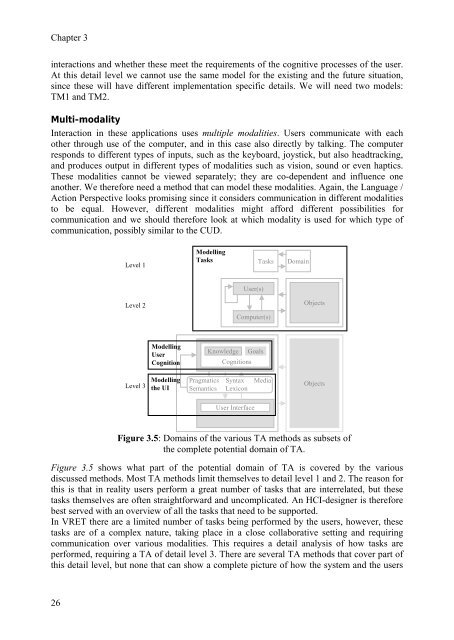Human-Computer Interaction and Presence in Virtual Reality
Human-Computer Interaction and Presence in Virtual Reality
Human-Computer Interaction and Presence in Virtual Reality
Create successful ePaper yourself
Turn your PDF publications into a flip-book with our unique Google optimized e-Paper software.
Chapter 3<br />
<strong>in</strong>teractions <strong>and</strong> whether these meet the requirements of the cognitive processes of the user.<br />
At this detail level we cannot use the same model for the exist<strong>in</strong>g <strong>and</strong> the future situation,<br />
s<strong>in</strong>ce these will have different implementation specific details. We will need two models:<br />
TM1 <strong>and</strong> TM2.<br />
Multi-modality<br />
<strong>Interaction</strong> <strong>in</strong> these applications uses multiple modalities. Users communicate with each<br />
other through use of the computer, <strong>and</strong> <strong>in</strong> this case also directly by talk<strong>in</strong>g. The computer<br />
responds to different types of <strong>in</strong>puts, such as the keyboard, joystick, but also headtrack<strong>in</strong>g,<br />
<strong>and</strong> produces output <strong>in</strong> different types of modalities such as vision, sound or even haptics.<br />
These modalities cannot be viewed separately; they are co-dependent <strong>and</strong> <strong>in</strong>fluence one<br />
another. We therefore need a method that can model these modalities. Aga<strong>in</strong>, the Language /<br />
Action Perspective looks promis<strong>in</strong>g s<strong>in</strong>ce it considers communication <strong>in</strong> different modalities<br />
to be equal. However, different modalities might afford different possibilities for<br />
communication <strong>and</strong> we should therefore look at which modality is used for which type of<br />
communication, possibly similar to the CUD.<br />
Level 1<br />
Level 2<br />
Level 3<br />
Modell<strong>in</strong>g<br />
User<br />
Cognition<br />
Modell<strong>in</strong>g<br />
the UI<br />
Modell<strong>in</strong>g<br />
Tasks<br />
Pragmatics<br />
Semantics<br />
Knowledge<br />
User(s)<br />
<strong>Computer</strong>(s)<br />
Cognitions<br />
Syntax<br />
Lexicon<br />
User Interface<br />
Tasks Doma<strong>in</strong><br />
Objects<br />
Figure 3.5 shows what part of the potential doma<strong>in</strong> of TA is covered by the various<br />
discussed methods. Most TA methods limit themselves to detail level 1 <strong>and</strong> 2. The reason for<br />
this is that <strong>in</strong> reality users perform a great number of tasks that are <strong>in</strong>terrelated, but these<br />
tasks themselves are often straightforward <strong>and</strong> uncomplicated. An HCI-designer is therefore<br />
Goals<br />
Media<br />
Objects<br />
Figure 3.5: Doma<strong>in</strong>s of the various TA methods as subsets of<br />
the complete potential doma<strong>in</strong> of TA.<br />
best served with an overview of all the tasks that need to be supported.<br />
In VRET there are a limited number of tasks be<strong>in</strong>g performed by the users, however, these<br />
tasks are of a complex nature, tak<strong>in</strong>g place <strong>in</strong> a close collaborative sett<strong>in</strong>g <strong>and</strong> requir<strong>in</strong>g<br />
communication over various modalities. This requires a detail analysis of how tasks are<br />
performed, requir<strong>in</strong>g a TA of detail level 3. There are several TA methods that cover part of<br />
this detail level, but none that can show a complete picture of how the system <strong>and</strong> the users<br />
26
















